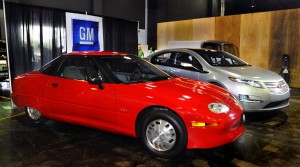
GM's EV1 was ahead of its time but more modern battery cars, like the Chevy Volt, may face the realities of a failing electric grid.
Who Killed the Electric Car? Forget the movie of a few years back that pointed its finger at General Motors for crushing up all the old EV1 battery-electric vehicles. The filmmaker recently released a sequel that actually praised GM for launching the new Chevrolet Volt plug-in.
In fact, I have a Volt parked in my driveway this week, tethered to an extension cord sucking up juice. As I reported some months back, it’s a pleasant vehicle to drive and does pretty much what the maker promises. When it can get power, that is.
I started this commentary a bit more than a week ago while sweltering in the 100-degree heat. No, I’m not a glutton for punishment. My home/office air conditioning was out – ultimately for four days – due to the latest in a seemingly endless series of blackouts courtesy of our local utility, DTE. The computer still worked, thanks to an instant-on generator I had installed two years earlier. At the time, I went for a system that wouldn’t be able to power my entire home because, heck, how often does the power go down? During just the first six months after installation, it turned out, the answer was 13 – a baker’s dozen blackouts that ran anywhere from a half hour to several days. Things haven’t improved much since then.
Which brings me back to electric vehicles. Had I been driving the Volt a week back, I’d have been out of luck. Well, stuck driving it in conventional mode. A Nissan Leaf would’ve been stuck in the driveway entirely. And that may reveal the single biggest concern about the current push for battery power. True, the first generation of electric vehicles have their problems – high cost, limited range – but the real concern is the national infrastructure. The grid simply isn’t ready to support a flood of electric cars all sucking off the energy teat.
According to a spokesman for DTE, my neighborhood and the surrounding communities have been targeted by both the utility and several partner automakers as ripe for “early adapters.” Indeed, one of my neighbors was looking at several possible battery cars, including the Leaf, the Volt and one of the new models Ford plans to introduce in the coming months. Note the use of the past tense. He’ll stick with something more conventional, he says, after going through the long blackout.
Another DTE official insisted that the condition we experienced was not unique to our old community. It’s difficult to come up with industry-wide figures, but it appears he’s right. Much of the country is vulnerable to electric disruptions, and not just during record heat waves. A check of the papers will reveal that snow and ice storms are frequently to blame during harsh Midwest winters. A Toyota executive tells me his California community often goes dark when it rains and shorts out the town’s underground grid.
Sure, you might say that these are just occasional inconveniences – but tell that to someone whose car can’t run because its batteries didn’t get the chance to recharge.
Weather problems are frequently the cause of service disruptions, but there are plenty of reports that warn that the national electric infrastructure is already being pushed to the limits. A major portion of Texas lost power last year when wind generators went off line. Who can forget the rolling blackouts in California, a few years back?
There’s plenty of talk about upgrading to a national “smart grid,” something we desperately need. But we also need not only more generation capacity but a huge upgrade of the basic electric infrastructure. In our region of Detroit, blackouts are likely as not the result of aging power lines and transformers. And that appears to be a common issue nationwide.
For American motorists to get charged up about battery cars will require that they also feel confident about having power when they need it. And that’s not just overnight when demand on the grid is lowest, as the industry likes to portray. People like to make sure they have their cars ready to go whenever they need them. If you can’t charge up during the day while the car’s parked outside your office, or in the evening when you come home, the appeal greatly diminishes.
For the moment, there aren’t enough battery cars to make a difference. But the Obama Administration has been talking about putting a million plug-ins and BEVs on the road by mid-decade. That’s a lot to be plugging in every day. Especially in older communities like mine, it’s a question whether the grid can cope.
DTE, in particular, has a program underway to help battery car buyers install the necessary chargers. What may be more useful is for the utility – and others across the country – to first upgrade their service. Otherwise they might be the ones being blamed in a movie sequel: Who Killed the Electric Car – Again?

The current administration’s goal for a million plug-ins is just another line to read on the teleprompter. In the same category as “shovel-ready jobs.”
Hi, Randy,
Or weapons of mass destruction…or…
Yep, we hear a lot of these lines. However, the admin’s extensive investment in battery-based technology does suggest that — rightly or wrongly, a matter for a separate debate — the White House DOES believe in the technology and IS taking steps to promote battery power. That’s not always the case. FYI, recall that a large chunk of the spending on the stimulus bill, originally earmarked for actual work creation, actually wound up going in a compromise in the form of tax cuts for the most affluent Americans. Which portion of the stimulus spending has so far produced more results, albeit the indication there haven’t been enough jobs created?
Paul A. Eisenstein
Publisher, TheDetroitBureau.com